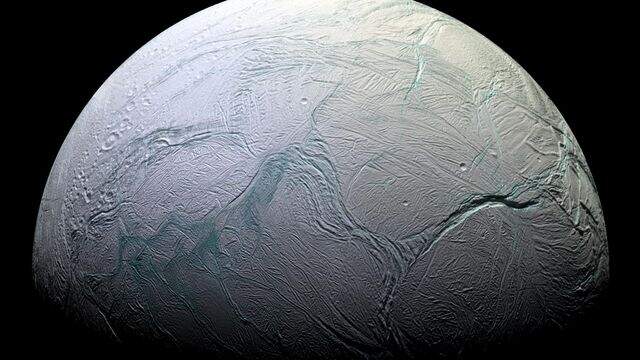
The study reveals discoveries about the energy source and key molecule of life on the gas planet’s natural moon. (Image: NASA/JPL/Space Science Institute)
A study published in the journal Nature Astronomy revealed that scientists have found evidence of an energy source and a key molecule for the origin of life on Saturn’s icy moon Enceladus.
NASA’s Cassini mission has already revealed that the stream of ice grains and water vapor leaving Enceladus’ south pole is rich in organic compounds important for life, Phys.org reported. Now, researchers have analyzed data from the mission and confirmed the presence of hydrogen cyanide, a molecule essential to the origin of life.
“Our work provides further evidence that Enceladus hosts some of the molecules most important for forming the building blocks of life and sustaining that life through metabolic reactions,” said study lead author Jonah Peter, a doctoral graduate student at Harvard who conducted the study. Much of the research was done while working at NASA’s Jet Propulsion Laboratory in Southern California.
Not only does Enceladus appear to meet the basic requirements for habitation, but we now have an idea of how complex biomolecules formed there and what types of chemical pathways might be involved.
Discovery
Moreover, they discovered that Enceladus’ subsurface, which feeds the jets, contains a powerful source of chemical energy, consisting of various organic compounds that serve as fuel for living organisms;
These discoveries indicate that Enceladus may contain much more chemical energy than previously thought, increasing the possibility of life on Saturn’s moon.
– Researchers claim that Enceladus not only meets basic requirements for habitation, but also provides clues about how complex biological molecules form and the chemical pathways that may be involved in them;
The study authors used detailed statistical analyzes to confirm the presence of these substances.
“The discovery of hydrogen cyanide was particularly exciting because it represents the starting point for most theories about the origin of life,” Peter said.
Life as we know it requires building blocks such as amino acids, and hydrogen cyanide is one of the most important and versatile molecules needed to form amino acids. Because its molecules can be stacked in many ways, researchers refer to hydrogen cyanide as the Swiss Army knife of amino acid precursors.
The more we tried to find flaws in our results and test alternative models, the stronger the evidence became. Eventually, it became clear that there was no way to match the column composition without including hydrogen cyanide.
“If methane generation is like a small watch battery in terms of energy, then our results suggest that Enceladus’s ocean may offer something more like a car battery, capable of providing large amounts of energy for any life that might exist,” he said. Kevin Hand of JPL and co-author of the study.
There are many potential pieces of the puzzle that can be fitted together when trying to integrate observed data. We use mathematical and statistical modeling to figure out which combination of puzzle pieces best matches the column configuration and makes the most of the data without over-interpreting the limited data set.
Cassini mission
The Cassini mission, which ended in 2017, continues to provide important information about Saturn and its moons, such as Enceladus. These discoveries expand our understanding of the possibilities for extraterrestrial habitability.

“Friendly zombie fanatic. Analyst. Coffee buff. Professional music specialist. Communicator.”
